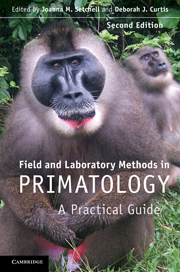Book contents
- Frontmatter
- Contents
- List of contributors
- Foreword by Robert D. Martin
- Introduction
- 1 An ethnoprimatological approach to interactions between human and non-human primates
- 2 Habituating primates: processes, techniques, variables and ethics
- 3 Habitat description and phenology
- 4 Geographical information systems and remote sensing
- 5 Monitoring local weather and climate
- 6 Survey and census methods: population distribution and density
- 7 Trapping primates
- 8 Handling, anaesthesia, health evaluation and biological sampling
- 9 Morphology, morphometrics and taxonomy
- 10 Marking and radio-tracking primates
- 11 Field experiments with non-human primates: a tutorial
- 12 Feeding ecology, frugivory and seed dispersal
- 13 Dietary analysis I: food physics
- 14 Dietary analysis II: food chemistry
- 15 Collecting arthropods and arthropod remains for primate studies
- 16 Recording primate vocalizations
- 17 Photography and video for field researchers
- 18 Chronobiological aspects of primate research
- 19 Thermoregulation and energetics
- 20 Field endocrinology: monitoring hormonal changes in free-ranging primates
- 21 Collection, storage and analysis of non-invasive genetic material in primate biology
- 22 Tips from the bush: an A–Z of suggestions for successful fieldwork
- Index
- References
18 - Chronobiological aspects of primate research
Published online by Cambridge University Press: 05 June 2012
- Frontmatter
- Contents
- List of contributors
- Foreword by Robert D. Martin
- Introduction
- 1 An ethnoprimatological approach to interactions between human and non-human primates
- 2 Habituating primates: processes, techniques, variables and ethics
- 3 Habitat description and phenology
- 4 Geographical information systems and remote sensing
- 5 Monitoring local weather and climate
- 6 Survey and census methods: population distribution and density
- 7 Trapping primates
- 8 Handling, anaesthesia, health evaluation and biological sampling
- 9 Morphology, morphometrics and taxonomy
- 10 Marking and radio-tracking primates
- 11 Field experiments with non-human primates: a tutorial
- 12 Feeding ecology, frugivory and seed dispersal
- 13 Dietary analysis I: food physics
- 14 Dietary analysis II: food chemistry
- 15 Collecting arthropods and arthropod remains for primate studies
- 16 Recording primate vocalizations
- 17 Photography and video for field researchers
- 18 Chronobiological aspects of primate research
- 19 Thermoregulation and energetics
- 20 Field endocrinology: monitoring hormonal changes in free-ranging primates
- 21 Collection, storage and analysis of non-invasive genetic material in primate biology
- 22 Tips from the bush: an A–Z of suggestions for successful fieldwork
- Index
- References
Summary
INTRODUCTION
Terrestrial animals live in an environment that undergoes regular variations, ultimately induced by the geophysical conditions prevailing in our solar/Earth system. Solar radiation and gravity, in combination with the Earth's rotation around its inclined axis and its orbit around the sun, and the moon's revolution around Earth, produce marked diurnal, seasonal and lunar as well as tidal periodicities in important physical environmental factors, such as light intensity, ambient temperature, humidity, precipitation, day and night length, and duration of twilight. As a consequence of the superimposition of these periodicities on one another, many relevant biotic environmental factors, such as food availability and predator pressure, as well as social contact, communication and competition with conspecifics, and intra- and interspecific competition for food may also vary diurnally, seasonally, lunar periodically or tidally. In this way, each animal's environment has a highly complex time structure, is highly repetitive in time and thus highly predictable. Reliable predictability provides a good substrate for genetically fixed adaptations. Hence, in addition to other general or specific physiological, ecological and/or behavioural adaptations, animals have also evolved endogenous diurnal (circadian), annual (circannual), lunar (circalunar) and/or tidal (circatidal) rhythms.
In non-human primates (hereafter ‘primates’), adaptation to the time structure of the physical and biotic environment is restricted mainly to the development of a circadian timing system, which is involved in the regulation of the pronounced daily (circadian) organization of physiology and behaviour.
- Type
- Chapter
- Information
- Field and Laboratory Methods in PrimatologyA Practical Guide, pp. 319 - 338Publisher: Cambridge University PressPrint publication year: 2011
References
- 5
- Cited by



